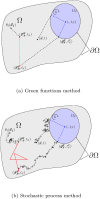Coupling radiative, conductive and convective heat-transfers in a single Monte Carlo algorithm: A general theoretical framework for linear situations
- PMID: 37023098
- PMCID: PMC10079137
- DOI: 10.1371/journal.pone.0283681
Coupling radiative, conductive and convective heat-transfers in a single Monte Carlo algorithm: A general theoretical framework for linear situations
Abstract
It was recently shown that radiation, conduction and convection can be combined within a single Monte Carlo algorithm and that such an algorithm immediately benefits from state-of-the-art computer-graphics advances when dealing with complex geometries. The theoretical foundations that make this coupling possible are fully exposed for the first time, supporting the intuitive pictures of continuous thermal paths that run through the different physics at work. First, the theoretical frameworks of propagators and Green's functions are used to demonstrate that a coupled model involving different physical phenomena can be probabilized. Second, they are extended and made operational using the Feynman-Kac theory and stochastic processes. Finally, the theoretical framework is supported by a new proposal for an approximation of coupled Brownian trajectories compatible with the algorithmic design required by ray-tracing acceleration techniques in highly refined geometry.
Copyright: © 2023 Tregan et al. This is an open access article distributed under the terms of the Creative Commons Attribution License, which permits unrestricted use, distribution, and reproduction in any medium, provided the original author and source are credited.
Conflict of interest statement
The authors have declared that no competing interests exist.
Figures











References
-
- Kay TL, Kajiya JT. Ray tracing complex scenes. ACM SIGGRAPH computer graphics. 1986;20(4):269–278. doi: 10.1145/15886.15916 - DOI
-
- Glassner AS. An introduction to ray tracing. Morgan Kaufmann; 1989.
-
- Delatorre J, Baud G, Bézian JJ, Blanco S, Caliot C, Cornet JF, et al.. Monte Carlo advances and concentrated solar applications. Solar Energy. 2014;103:653–681. doi: 10.1016/j.solener.2013.02.035 - DOI
-
- Villefranque N, Fournier R, Couvreux F, Blanco S, Cornet C, Eymet V, et al.. A Path-Tracing Monte Carlo Library for 3-D Radiative Transfer in Highly Resolved Cloudy Atmospheres. Journal of Advances in Modeling Earth Systems. 2019;11(8):2449–2473. doi: 10.1029/2018MS001602 - DOI
-
- Fournier R, Blanco S, Eymet V, El Hafi M, Spiesser C. Radiative, conductive and convective heat-transfers in a single Monte Carlo algorithm. In: Journal of Physics: Conference Series. vol. 676. IOP Publishing; 2016. p. 012007.
Publication types
MeSH terms
LinkOut - more resources
Full Text Sources

